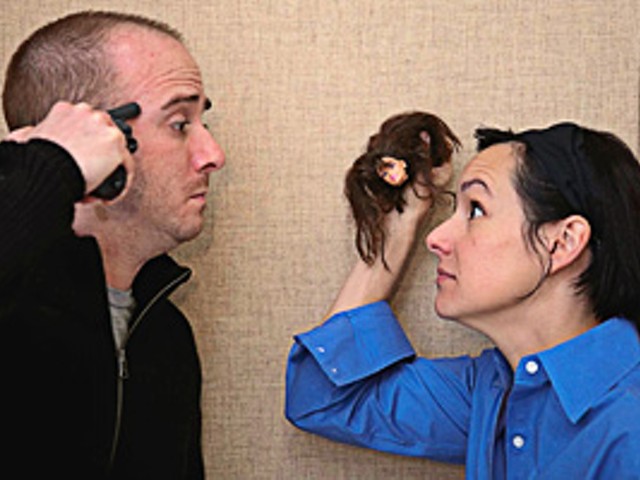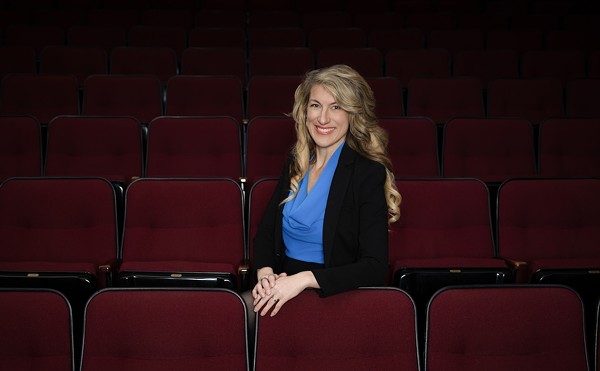Holiness: In 3 Parts Reviewed in this issue. Ongoing
Anne Appleby These paintings and printed works make a close study of the memory of nature, distilled here in a luminous inventory of saturated natural hues. Appleby crafts her oil and wax pieces in a studio on a mountaintop in Montana, where previously observed landscapes — trees leafing out in the Catskills, for instance — are remembered by their colors only and painted in dense layers on wood or canvas. The artist's most recent work, which consists of a series of prints made locally at Wildwood Press, is born of a similar process: The colors of a sweet pea plant or a mulberry tree imbue squares of loosely hanging handmade paper. A sheet of maize appears subtly shot through with a deep red or green — revealed in the paper's thinner spots or at the frayed layers of its deckled edge, which expose bright underpainting and a second layer of printed paper. The effect is contemplative and precisely restrained and speaks to an essence that can only be generated by patient and rigorous toil. Through October 10 at Schmidt Contemporary Art, 615 North Grand Boulevard; 314-575-2648 or www.schmidtcontemporaryart.com. Hours: noon-5 p.m. Wed.-Fri., 10 a.m.-4 p.m. Sat.
Exposure 12: Implied Narratives: Paintings by Jamie Adams, Bill Kreplin and Kit Keith For this year's installment of the annual "Exposure" series, which typically highlights new and notable St. Louis-area artists, curator Terry Suhre selected three mid-career painters to display their current work. The resulting exhibition is a mature exploration of figuration and personal narratives, as channeled through familiar pop-cultural tropes. Jamie Adams merges Mannerism with French New Wave cinema in a series of complexly composed black-and-white paintings that fetishize Godard's coolly tragic Breathless star, Jean Seberg. Bill Kreplin reinvokes prototypical McCarthy-era suburbia embroiled in suggestively code-deviant scenarios in line drawings with sparing decorative patterns and brush-painted color. Kit Keith paints and repaints a round, dark-haired female face over maps, a page from a petty-cash log and other found antique ephemera in a way that suggests that even the subtlest side glances and twists of mouth are betraying. While each artist is making a project of playing with iconic sources and their respective freight of associations, the exhibit is refreshing for its skilled directness, appealing to our most fundamental ways of discerning meaning in one another: through stories, facial expressions, the movements of the body. Also showing: In a new gallery devoted to video art, the piece Phosphorescence, by Oakland-based artist Anthony Discenza, turns televisual images into lilting ambient abstractions. Through October 10 at Gallery 210, Telecommunity Center, University of Missouri-St. Louis, 1 University Boulevard (at Natural Bridge Road); 314-516-5976 or www.umsl.edu/~gallery. Gallery hours: 11 a.m.-5 p.m. Tue.-Sat.
Ideal (Dis-)Placements: Old Masters at the Pulitzer This exhibition of canonical canvases of slain martyrs, pious virgins and other grand dilemmas borrowed from two encyclopedic museums and replaced in naturally lit contemporary galleries is a reaffirmation of the human scale. The minimalism of Tadao Ando's building design is diffused by ornate, gilt-framed compositions that date from the fourteenth to the eighteenth century, the two historical extremes meeting precisely at the fragile effects of daylight on the predominantly figural pieces. Contemplative and reverent, the show fulfills its premise so well that it seems capable of providing a discretely intimate experience for each and every viewer. Through October 3 at the Pulitzer Foundation for the Arts, 3716 Washington Boulevard; 314-754-1850 or www.pulitzerarts.org. Hours: noon-5 p.m. Wed., 10 a.m.-5 p.m. Sat.
Relics of a Glorious Past: Imperial Russian Artifacts from the Collection of Dr. James F. Cooper This assemblage of orthodox icons and the daily stuff of royalty forms a two-part essay on lost cultural splendor and the bygone transcendent art object. Framed in gilt halos, pounded metal and semiprecious stones, the small tempera-on-wood devotional paintings exemplify an anonymous milieu in which studied replication was prized over innovation, and communion with the immaterial was the subject matter of choice. Similarly, the gold-rimmed teaspoons, military regalia and assorted decorative pieces from the show's secular portion involve such an engaged level of tactile detail that they could be considered devotionally crafted. The exhibit as a whole serves as a useful reference point for contemporary art's renewed interest in gold, which seems to signify a nostalgia for creative acts deemed sacred and authentic. Through December 20 at the Saint Louis University Museum of Art, 3663 Lindell Boulevard; 314-977-2666 or sluma.slu.edu. Hours: 11 a.m.-4 p.m. Wed.-Sun.
Singing the Body Electric The title is borrowed from Walt Whitman's exuberant celebration of the body and health, but the show, comprising works by three area artists, is more conceptually akin to Susan Sontag's Illness as Metaphor or Thomas Mann's Magic Mountain. The works explore disease as an allegory for societal ills as well as for the process of art-making (which often takes place in its own version of quarantine). Lindsay Obermeyer renders pink and blue pathogens from shimmering sequins and beads that populate a gallery wall. Julia Wilkey stitches over steel trays, IV bags and other hospital artifacts with red thread. Julia Karll twists torn pieces of the daily news into long, thick strands, then bundles them in a massive knot. There is a sense in these pieces of time anxiously passing while monumental events — inside the body, out in the world — continue to transpire beyond our control. And yet the fact that these artists have created something out of this notion of impotence amounts to a form of productivity — curator Sarah Colby characterizes it as "minumental" — that celebrates merely being here. Through October 11 at the Regional Arts Commission, 6128 Delmar Boulevard; 314-863-5811 or www.art-stl.com. Hours: 9 a.m.-5 p.m. Mon.-Fri., noon-5 p.m. Sat.-Sun.
Thomas Struth In a masterfully resonant gesture, two large-format photographs by the notable German photographer Thomas Struth have replaced the collection of old-master drawings in the Pulitzer Foundation's lower gallery. The images, Pantheon, Rome and The Restorers at San Lorenzo Maggiore, Naples, immediately predate his seminally elegant "Museum" series (which depicted people viewing canonical works of art in the world's canonical museums), but share that series' concern with the phenomenon of viewership and space. One photograph shows a cluster of minute-seeming tourists gaping skyward at the enormity of the ancient Roman sacred space; the other captures a small group of employees in the museum's rear quarters, gazing directly at the camera while rows of historical paintings lean almost casually against a wall behind them. As a pair, the photographs perform a rich exercise in perception and scale, in which you, the viewer, contemplate other viewers' contemplations of represented space, while simultaneously enacting the same action. Furthering this effect, when ascending the stairs from the lower gallery, the severe modernity of the museum suddenly resonates with Struth's ornate grand halls and coffered rotundas — making the contemporary world, for a miraculous moment, the logical conclusion of history. Through October 3 at the Pulitzer Foundation for the Arts, 3716 Washington Boulevard; 314-754-1850 or www.pulitzerarts.org. Hours: noon-5 p.m. Wed., 10 a.m.-4 p.m. Sat.
Tom Huck and the Rebellious Tradition of Printmaking Brandy Baghead is going through major changes in Tom Huck's new triptych, on view at the Saint Louis Art Museum after two years in meticulous production. The printmaker from the self-fabled rural backwaters of Potosi hewed The Transformation of Brandy Baghead as the centerpiece of his third series of woodcuts, "Booger Stew," which vivisects contemporary phenomena such as reality television and self-actualization by way of Barbie doll beauty. Modeled after three-part altarpieces (a form that reached its gruesome apogee in the gnarled crucifixions of the Northern Renaissance), Brandy Baghead is equal parts Matthias Grünewald, Garbage Pail Kids and House of 1,000 Corpses. Once a wholesome beauty queen, Brandy subjects herself to the nails, crowbars, cat intestines and electrical tape of mad surgeons giddy to transform her into their world's prevailing physical ideal: a breast-enhanced ice-skating chicken-oid. They succeed, to the frothing admiration of the populace, who wave signs of such high accolades as "cooz" and "skank" as she skates, proudly cross-eyed and feathered, on black ice. The uncomfortably gorgeous trio of images appears amid a selection of historical prints chosen by Huck to illustrate his influences, each annotated with his plainspoken take on the work. This short history of printed art, which includes Albrecht Dürer, William Hogarth, James Ensor, José Posada and Max Beckmann, depicts a medium hell-bent on disseminating images of bourgeois grotesqueries, rampages of moral vindication and the human herd as a macabre carnival of souls. Huck comes across as not only the real deal but a worthy inheritor of the legacy — thanks to the ambitious and obsessive scale of his work. These prints add up to truly fucked-up stuff of the highest order. (Ian Froeb's profile of Tom Huck, "Evil Ink," was published January 18, 2007, and is available at www.riverfronttimes.com.) Through November 15 at the Saint Louis Art Museum, 1 Fine Arts Drive (in Forest Park); 314-721-0072 or www.slam.org. Hours: 10 a.m.-5 p.m. Tue.-Sun. (10 a.m.-9 p.m. Fri.)
Way Out of Line Distilling the art of drawing to its essence — the line — this group exhibition of work by Washington University MFA candidates presents a wide range of ways to make a mark without resorting to pencil-and-paper conventions. Mary Beth Hassan hangs two slightly mangled window screens side by side; their pairing, material modesty and mild derangement contribute a larger, if incidental depth to their simpler function as a linear grid. John Early's No Where Will These Two Lines Appear Further Apart Than at the Point You Stand Between Them consists of two parallel strips of black tape that bisect the gallery space and conclude in upright mirrors. Their path of infinite self-reflection speaks of larger, metaphysical concepts via a well-considered economy of means. A rhythmic thwacking noise permeates the gallery; its source, one discovers, is a mechanical mechanism that sends pieces of charcoal in a perpetual spiral, creating scuffs on a narrow constructed wall. The piece, by Andrew Cozzens, has great potential as a producer of the kind of incidental racket that, say, a neighbor's unlatched screen door makes, but it's overdesigned as a quirky drawing machine. The strongest works in the show are the simplest ones, the ones that betray the least whiff of formal, studio exercise and instead mine the peculiar nuances of the artist's personal realms, where lines are revealed as the material of everything intimately observable. Playfully curated by Mamie Korpela. Through October 25 at the Des Lee Gallery, 1627 Washington Avenue (University Lofts Building); 314-621-8537. Hours: 1-6 p.m. Thu.-Sat.
We Are Here This elegant and succinct show consists simply of two works: a pair of blue hooded sweatshirts on hangers, with their empty arms interlaced as though they were holding hands; and a series of twelve photographs. The photos depict the artist, Nathan Keay, sleeping on various friends' sofas. The lighting is uniformly diffuse; the only markers of the casual difference between households are the different assortments of floor lamps, coffee tables and strewn detritus. Created in the aftermath of his wife's unexpected death, Keay's work manages to negotiate the intimacy of autobiography and personal anguish with a generous and deft sense of making public art. Through the simplest of means, the broader realms of comfort and the quiet vagaries of loss are subtly yet amply expressed. Also showing (in Drive By): Bryan Eaton's Nothing Lasts Forever, a massive necklace of wooden chain saws, which functions as hard labor's ultimate merit badge. Through October 28 at Snowflake/Citystock, 3156 Cherokee Street (www.snowflakecitystock.com). Hours: 11 a.m.-3 p.m. Sat.





